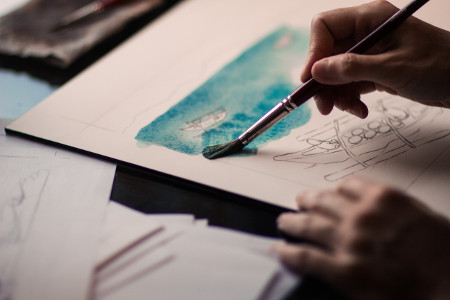
Basic Nutrition 2020-21
Unit-1
A.Nutrients in food:Defination,functions,sources,recommended dietary allowance,effects of deficiency and excess (in brief)of Carbohydrates,Proteins,Lipids.
B.Water-Functions and sources of water for human body,effects of excess and low intake of water on human body.
C.Fibre-Types,Functions or role of dietary fibre in the human body,sources.
Unit -2
A.Functions,sources,recommended dietary allowances,effects of excess and deficiency (in brief)of:Fat soluble vitamins(A,D,E and K)and water soluble vitamins(C,B1,B2,B6,B12,Niacin and Folic Acid).
B.Functions,Sources,RDA,Effects of Excess and low intake of Macro Minerals(Calcium,Magnesium,Phosophorus,Sodium,and Potassium and Micro minerals(Iron,Iodine and Fluorine).

Add on Course:Cosmetology 2020-2021
Cosmetology is the art and science of improving and beautifying the hair, skin, and nails. Students learn to work with these parts of the human body, studying cosmetics, therapeutic treatments, and beauty processes.
Cosmetologists help clients achieve their beauty goals through both classic and innovative beauty treatments. The ever-changing beauty industry offers plenty of career opportunities for working professionals.

ADVANCE APPAREL & TEXTILE DESIGNING
B.Sc. III (HOME SCIENCE)
SEMESTER – V
ADVANCE APPAREL & TEXTILE DESIGNING
UNIT-I
A. Fashion in dress
• Definition
• Factors favoring and retarding fashion
B. Figure Analysis
• Selection of design in relation to figure types
C Fitting: Common fitting problems and remedies for fitting defects, reasons for
poor fitting.
UNIT-II
A. Textiles Designing: - Meaning and importance
B. Designing techniques:
• Dyeing: classification, household dyeing – process, classification and faults in
dying. Resist dying ( tie & dye and Batik) – tools required and methods of
producing different effects..

Certificate Course:Apparel Designing 2020-2021
The Apparel Design course involves technical and artistic creativity for the fashion Industry, where apparel designers need to conceptualize, create as well as monitor the manufacturing of clothes. A person specializing in this stream work in the broad areas of the Apparel Industry such as Ready to Wear, Specialized Fashion , Active wear, Sports Wear, Functional Clothing (clothes specially designed for particular profession) etc.
The course in Apparel Designing involves studying history of Costumes, fashion designing, science and liberal arts, design management, fashion art and sketching, production of cloth, Apparel pattern making, different kinds of knitting, trends and forecasting for Apparel, Design Process, production and planning, retailing and marketing.
CAREERS:
Apparel Designer – The Apparel designer is involved in designing and maintaining clothing line of an apparel brand. They create, illustrate designs, pattern, estimate cost of manufacturing, and maintain their associated brands' clothing line.
Fashion Trends Forecasters – The fashion industry is ever-changing, every day a new trend is set, therefore, as fashion forecasters, they are required to research and analyze the worldwide fashion industry. The fashion forecasters work with fashion designers to identify and create apparel designs that will set the trends in the market.
Apparel Quality controllers– The quality controllers are involved in setting standards for fabric to differentiate original and quality products from faux material. They are responsible for maintaining a differentiation in quality of original fabrics from synthetic ones and also making the consumer aware of it. Some manufacturers adopt the unethical practice of selling faux material as the original at a high cost

Community Development & Extension Education-I
A. Social Structure and systems:
-Meaning and elements of organization and social structure.
-Social system-Its characteristics and relation with social structure.
-Types of society.
B. Analysis of the family as a social unit.
Family-its meaning,characteristics,types on basis of size,marriage,authority and nature of relation.
C. Communication-Meaning,importance,functions and factors influencing effective communication,key elements in the communication process.
UNIT-II
D. Poverty analysis:Defination,effects of poverty,measurements,cause of poverty,programmes for poverty alleviation.
E. Planning,controlling and evaluation of development programmes for women and children-DWACRA,TRYSEM,ICDS,ANP,SNP,MIDDAY MEAL PROGRAMME.
F. National agencies-NREGA,DRDA,PMRY.

Community Development Extension Education-II 2020-2021
Community Development
A.Defination,purpose and goals,process of development.
B.Community development programmes in India,its objective and critical analysis.
C.Audio visual aids-Defination,classification,importance,Use of projected and none projected aids(in brief)
Extension Education
A.Philosophy,principles,objectives,concepts and scope of extension education.
B.Qualities of a good extension worker.
C.Home Science-Its meaning,history in India,Role of Home Scientists in community development.
D.Programme Planning-Meaning,Importance and steps.

Dietetics II 2020-2021
UNIT-I
Causes,Symptoms,Dietary modifications,prevention and nutritional management in the following.
- Diabetes Mellitus-IDDM,NIDDM
- Hypertension
- Heart Diseases-CHD,IHD
UNIT-II
Dietary management and diagnosis,cause,symptoms and dietary modification in the following.
- Acute and Chronic Renal Failure
- Nephritis
- Kidney Stones
- Cancer

Dietetics-I
A. Diet therapy,principle of diet therapy,adaptation of normal diet to light,soft,full fluid,clear fluid and bland diet.
B. Causes,symptoms and dietary modifications of the following:
-Diarrhea,Constipation,Peptic ulcer
-Fever
C.Dietary modification in surgical conditions.
UNIT-II
Causes,symptoms and dietary modifications of the following:
-Weight imbalance-Underweight,Overweight,Obesity
-Liver disorders-Jaundice,Viral Hepatitis,Cirrhosis and Hepatic Coma.
-Arthritis,Gout.